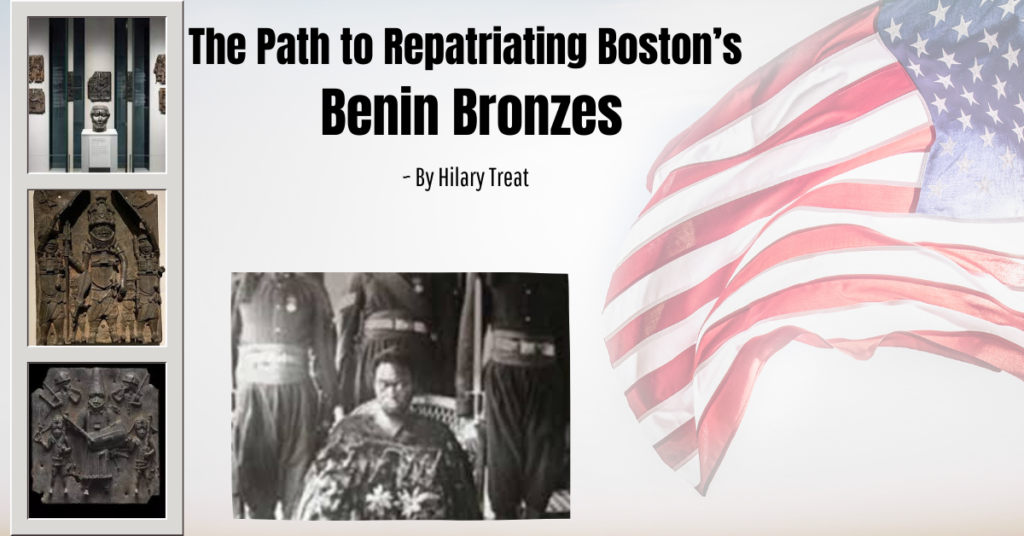In 1897, a British official, James Phillips asked the oba (king) of Benin (or Edo), a modern-day region in southern Nigeria, if he could come to Benin City on a trade mission. The oba said no, but James Philips came anyway. He and seven other British members of the party were killed along with over two hundred African members, who had been conscripted as carriers. The British responded within a month and captured Benin City, which they would hold until 1960. They ransacked the palace and looted anywhere between 3,000 and 10,000 artifacts. These pieces are collectively known as the Benin Bronzes. The name is a bit misleading because they are from the region Benin in Nigeria, not the country Benin, and they are largely not made from bronze. The entire collection includes metal works, ivory pieces, and wood plaques, and today these artifacts can be found everywhere on the globe, except in Nigeria.
Coming to Boston
Famous families and celebrities throughout recent history have owned Benin bronzes: “the Lehman, Rockefeller, Ford and de Rothschild families have owned some. So did Pablo Picasso. 1” 161 museums have Benin Bronzes in their collection, including Boston’s Museum of Fine Arts. In 2012, Robert Lehman gave 32 Bronzes to the MFA for their African collection. At the time, the Nigerian National Commission for Museums and Monuments made a statement condemning the donation, saying the Bronzes should be “returned to their home, where they will be meaningful. 2” However, at the same time, both the Oba Erediauwa I and the Benin Club of Massachusetts supported the gallery opening (Erediauwa’s successor, Ewuare II has called for the repatriation of the bronzes). Malcolm Rogers, the director of the MFA at the time, responded to criticism by saying, “We have every right in the world to own these beautiful pieces and make them available for the world public…It’s one of the most special things that museums do. We move objects into the public domain.” 3
The question of repatriation is something that museums around the world have grappled with for decades. The Parthenon Marbles or Elgin Marbles (depending on which side of the debate you’re on) are probably the most famous example of a repatriation dispute, but there have been many over the years which has caused museums to look very carefully at the provenance of the pieces in their collections. Rogers’ statement is a bit surprising given this landscape; it’s also surprising given the MFA’s exhibit three years later of the Rothschild collection of art that had been stolen by Nazis and then returned to the family years later. Rogers left the MFA the year of the Rothschild exhibit and he was replaced by Matthew Teitelbaum, who has walked a tightrope on the issue of the Benin Bronzes. On the one hand, under his leadership, the MFA has revamped the labels in the Africa collection which now fully explore the history of these pieces, including the fact that they were stolen and the museum “has continued to engage the Edo diaspora, with free museum admission, youth symposia, family events, and language lessons.4” But on the other hand, the director also points to 1.2 million annual visitors a reason to keep the Benin Bronzes.
Accessible for All?
The argument for keeping stolen pieces in foreign museums is that it means more people can view the art from a wider cross section of the population. This is especially true for larger museums like the British Museum and the Louvre which have millions of international visitors a year. However, in the case of the Benin Bronzes, the people who do not get to view the pieces are Nigerians. The Deputy Director and Curator of the Benin City National Museum, Theophilius Umogbai, visited the British Museum, but, as he says, “I went to the British Museum because my trip was sponsored. I wouldn’t have been able to go otherwise, even as a public servant.5” Museum curators from the region that the bronzes were taken from should be able to visit the pieces in the British Museum frequently, but it is very difficult for them, not to mention Nigerians who are not in elevated roles, like public servants, such as Umogbai.
Obstacles to Repatriation
There are some legal issues with repatriating the Benin Bronzes. For the ones specifically at the MFA, 27 of the 32 bronzes in the MFA’s collection are not owned by the museum but by Robert Lehman. Even if the MFA wanted to give the bronzes back to the Nigerians, they can’t give back something they don’t own. They could give back the five they do own, but that would put pressure on Lehman, and they are apparently reluctant to do that.
There is also a question more generally about who any of the bronzes would go to if they were returned. There are three potential claimants: the Nigerian federal government, the Edo State, and the oba of Benin. The MFA has said that the fact that there are three claimants is one of the reasons it hasn’t returned its five bronzes: the former curator of African and Oceanic art, Kathryn Wysocki Gunsch said, “It is not for art museums to adjudicate which claimant is the right claimant.6” To complicate matters further, the Edo State and the Oba of Benin are distinct entities, but the capital of the Edo State is Benin City, which is where the oba’s palace is. The oba and the governor of the Edo State work closely together, and the Edo State is a region of Nigeria, which is supposedly the third claimant. Other countries and museums, such as the University of Aberdeen and Jesus College, Cambridge, have not seen a problem as they have returned bronzes to the Nigerian High Commission without issue. Others have pledged to return theirs: Germany, the Met in New York, and the Smithsonian in DC have all pledged to return their bronzes. Additionally, auction houses are feeling pressure; Sotheby’s withdrew a $7 million ivory mask after receiving pressure from Nigeria.
There is a wave forming in favor of returning these pieces back to their country of origin. What will the MFA do in response? Can they maintain their position that they expose more people to and educate more people about the bronzes in Boston? It will be interesting to see. The museum world is starting to realize that labels showing the violent history of these pieces do not do enough to counter the violence of keeping them from their country of origin.
Do you think the Benin Bronzes should be returned? Why or why not?
- Alex Marshall, “This Art Was Looted 123 Years Ago. Will It Ever Be Returned?,” The New York Times, January 23, 2020, sec. Arts, https://www.nytimes.com/2020/01/23/arts/design/benin-bronzes.html.
- “Museum of Fine Arts Boston Gets Benin’s Royal Blessing over Bronzes Display,” The Art Newspaper – International art news and events, August 31, 2013, https://www.theartnewspaper.com/2013/09/01/museum-of-fine-arts-boston-gets-benins-royal-blessing-over-bronzes-display.
- Malcolm Gay Globe Staff et al., “For the MFA, Benin Bronzes Are a Troubling Gift – The Boston Globe,” BostonGlobe.com, accessed June 9, 2022, https://www.bostonglobe.com/2021/11/27/arts/mfa-benin-bronzes-are-troubling-gift/.
- Staff et al.
- “Benin Bronzes: ‘My Great-Grandfather Sculpted the Looted Treasures,’” BBC News, October 27, 2021, sec. Africa, https://www.bbc.com/news/world-africa-59065274.
- “The MFA Is Showing Looted African Art. Here’s How to Deal with It. – The Boston Globe,” BostonGlobe.com, accessed June 9, 2022, https://www.bostonglobe.com/2021/12/19/opinion/mfa-is-showing-looted-african-art-heres-how-deal-with-it/.


Pingback: Forgery and Inauthenticity in Museums - Artistic Connector